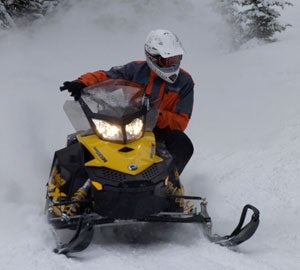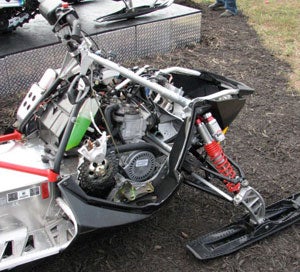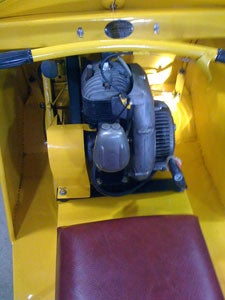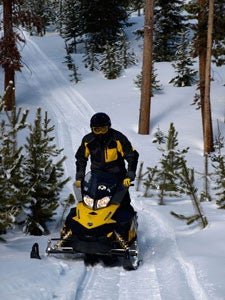Looking Safely Ahead

Can snowmobiling be made safer still?
It happens every year about this time, reports of snowmobile fatalities. We frequently wonder what could have been done differently to keep each of these accidents from happening. Obviously, the use of alcohol merits concern, as riding under the influence is not a good choice. Unfortunately there are always too many of those incidents — whether they are while driving a snowmobile, car or anything else.
But, when it comes to safety, what else could be done? We look at our cars and trucks and one obvious answer is brakes. Even my low buck, back-to-basics Jeep Wrangler comes equipped with anti-lock braking and electronic stability controls. Is it un-macho to consider such things for snowmobiling?
A Weird Lot
 Challenging corners are part of the fun in riding quickly. Would anti-lock brakes add an edge for safety.
Challenging corners are part of the fun in riding quickly. Would anti-lock brakes add an edge for safety. Modern sleds like this Polaris feature hydraulic brakes with lightweight brake rotors.
Modern sleds like this Polaris feature hydraulic brakes with lightweight brake rotors.We snowmobilers are a weird lot. If there is anything that adds weight to a sled, we seem to be against it. Think about it. When sleds weighed 250 pounds, we were against adding electric start. There was the weight of a battery, a starter plus added cables, nuts and bolts. When sleds weighed in at 500-plus pounds we were still opposed to electric start. What about reverse gear? Fortunately Rotax came up with electronic reverse for two-strokes, or we’d be yanking those quarter-ton sleds off our tilt trailers still!
We are seeing more sleds with standard electric gear like electric starting. That’s because we are seeing more four-stroke engines powering modern sleds. With this onboard capacity for electronic gear, maybe we should think about adding some safety gear that would add safer riding to our sleds. And, add more fun while it was happening.
Two Choices
When you head out on a trail, you have two choices. Speed up or slow down. The right thumb works a throttle flipper that will speed you up — or slow you down if you disengage it. Your left thumb or grip works the brake lever, which slows you down. It rarely stops you as effectively as an automotive braking system.
Not being an engineer, but having snowmobiled for quite a few years, we can state that snowmobile-braking systems have improved over the years. Today’s hydraulic systems work fairly well. But they are all prone to locking up the track under hard braking.
What happens? The track locks up. On a snowy trail a locked track can plow up an abundance of snow ahead of the track. On icy trails the track locks up and skids, making it very easy to spin, especially if you are already in a corner. What tends to be on the edges of the trails? Trees. Or other unpleasant things you really don’t want to hit.
Regardless of the specific situation, a locked track can lead to an accident. With snow plowed up, letting off the brake, unlocking the track and, perhaps, adding throttle can lead to on trail problems as the track takes a moment to start spinning again.
Adapting To “Normal”
 Old sleds relied on basic mechanical drum brakes.
Old sleds relied on basic mechanical drum brakes.Chances are that most of us have adapted to this “normal” braking — or, lack of braking — phenomena by simply relying on reading trail conditions. Many old timers rarely use the brake. After all, they started riding when mechanical band brakes passed as a sled’s braking system. Ask a vintage sled rider how effective most brakes are on those old crates. Chances are he might know. He might simply rely on backing off the throttle and using plain old friction to slow down, saving the brake for usage under 10 miles per hour.
Modern riders rely much more on the brakes. It can be interested riding in a group at night. Sometimes the frequency of brakes being applied in the corners looks like an ambulance racing to a disaster.
We wonder again about safety. We think that adding some kind of anti-lock braking system for a snowmobile should be a serious consideration by either the sled makers or an aftermarket company. This is not a frivolous consideration.
Controlling Power
With snowmobile engines supplying sleds with 150-plus horsepower and speeds easily in excess of 100 miles per hour for even average sport sleds, it would seem only logical that brake systems keep pace. Bringing a sled under control from 100 MPH requires serious braking power. While most brake systems will stop the track at such speeds, do they do it with the sled totally under control?
The idea of anti-lock braking is really quite simple. The premise would be to keep the track from totally locking up so that it could be stopped and, perhaps, safely steered away from a crash. If you consider the benefits of today’s modern ride-forward chassis designs, what happens when centered weight needs to be stopped quickly?
Think about where you sit. Where is the engine mass? How much weight is there on the total track surface touching the trail? Wouldn’t it seem appropriate to suggest that much of the weight sits forward and that quite a lot of the track surface sits rear of your butt? How much effective track surface is there available for serious braking?
Safe & Steerable
 Trees line both sides of many trails to catch unwary riders.
Trees line both sides of many trails to catch unwary riders.If you have some form of anti-lock braking system or stability control onboard, we suspect that a sled could stop more quickly in a straight line and most likely remain “steerable” to drive around an approaching obstacle.
We know that at least one snowmobile maker has taken this suggestion to heart and has experimented with some form of ABS. It has yet to appear. There is cost involved. Of course that will be a consideration. But, sleds no longer retail for $5,000 or less. Plus, modern snowmobiles come with some fairly sophisticated computer setups that means adding another circuit to a sled shouldn’t be that big of a deal. To accommodate these modern electronics, you’ll find sled motors putting out some serious wattage. Again, adding more circuitry and adding wattage isn’t a big deal, is it?
We look at ABS or stability controls as things that should be on modern sleds. Just as with our cars and trucks, there should be a switch to turn off the ABS or stability control if we want to over ride the system. While these are safety add-ons, the anti-locking brake system could help performance as you could actually run deeper into a corner and be under better control while doing it. That would make you faster — as well as safer!
We read about snowmobile accidents and wonder if they have to happen. What if we build better, more responsive, safer sleds and don’t read about so many snowmobiling accidents?
Related Reading Seeing the Light on Lite Why Modern Sleds Cost More A Future for Lightweight Fun Sleds The Ins and Outs of Sled Steering Control Top 10 Tips for Staying Safe on Ice








 Your Privacy Choices
Your Privacy Choices